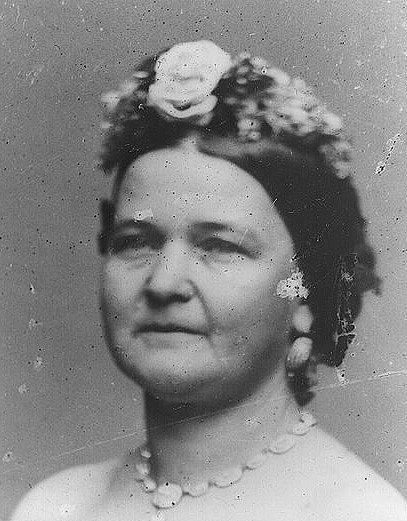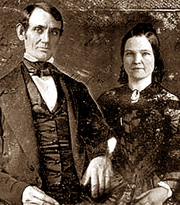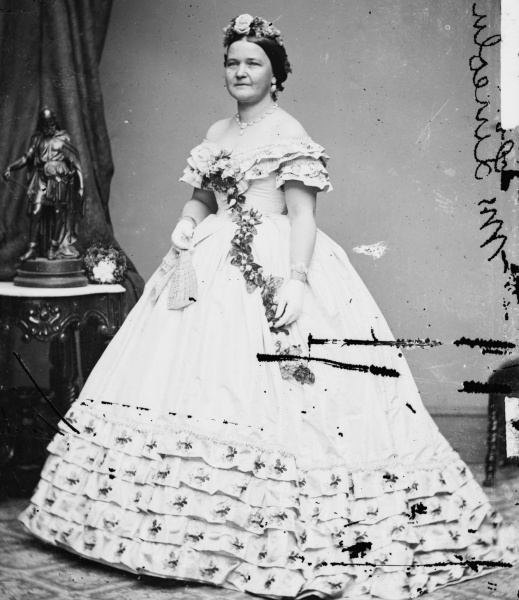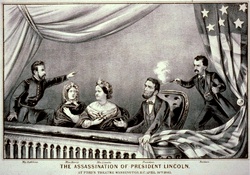|
MARY TODD LINCOLN
MARY TODD LINCOLN
(December 13, 1818 –
July 16, 1882)
Mary Ann Todd Lincoln (December
13, 1818 – July 16, 1882) was the wife of the 16th President of the United States, Abraham Lincoln, and was First Lady
of the United States from 1861 to 1865.
As a girlhood companion
remembered her, Mary Todd was vivacious and impulsive, with an interesting personality--but "she now and then could not restrain
a witty, sarcastic speech that cut deeper than she intended...." A young lawyer summed her up in 1840: "the very creature
of excitement." All of these attributes marked her life, bringing her both happiness and tragedy.
Daughter of Eliza Parker
and Robert Smith Todd, pioneer settlers of Kentucky, Mary lost her mother before the age of seven.
Her father remarried; and Mary remembered her childhood as "desolate" although she belonged to the aristocracy of Lexington, with high-spirited social life and a sound private education.
| Mary Todd Lincoln |

|
| (December 13, 1818 - July 16, 1882) |
| Abraham and Mary Todd Lincoln |

|
| (Wedding Day) |
Just 5 feet 2 inches at maturity,
Mary had clear blue eyes, long lashes, light-brown hair with glints of bronze, and a lovely complexion. She danced gracefully,
she loved finery, and her crisp intelligence polished the wiles of a Southern coquette.
(Wedding Day Photo) Abraham Lincoln,
age 33, married Mary Todd, age 23, on November 4, 1842, at the home of Mrs. Edwards in Springfield, Illinois. They would have
four children, although only their first-born son Robert would survive to adulthood.
Nearly 21, she went to Springfield,
Illinois, to live with her sister Mrs. Ninian Edwards. Here she met Abraham
Lincoln--in his own words, "a poor nobody then." Three years later, after a stormy
courtship and broken engagement, they were married. Though opposites in background and
temperament, they were united by an enduring love--by Mary's confidence in her husband's ability and his gentle consideration
of her excitable ways.
Interesting
Facts: John Cabell Breckinridge was a U.S. Vice President, the most senior
ranking public official to commit treason, cousin to Mary Todd Lincoln, presidential candidate (ran against Abraham
Lincoln), and prominent Confederate general. Breckinridge (often misspelled as Breckenridge),
furthermore, has witnessed only one full-length biography written about him. On the other hand, President Abraham Lincoln
has been honored with more than 14,000 biographies.

(Right) Mary Todd Lincoln
signature.
| Mary Todd Lincoln |

|
| Library of Congress |
Their years in Springfield
brought hard work, a family of boys, and reduced circumstances to the pleasure-loving girl who had never felt responsibility
before. Lincoln's single term in Congress, for 1847-1849, gave Mary and the boys a winter in
Washington, but scant opportunity for social life. Finally
her unwavering faith in her husband won ample justification with his election as President in 1860.
Their children, all born in Springfield,
were:
Robert Todd Lincoln (1843–1926)
– lawyer, diplomat, businessman.
Edward Baker Lincoln, known as "Eddie", (1846–1850)
William Wallace Lincoln,
known as "Willie", (1850–1862) died while Lincoln was President
Thomas Lincoln known as "Tad" (1853–1871)
| Assassination of President Lincoln |

|
| (President and Mrs. Abraham Lincoln) |
Though her position fulfilled her high social ambitions, Mrs. Lincoln's years in the White
House mingled misery with triumph. An orgy of spending stirred resentful comment. While the Civil War dragged on, Southerners
scorned her as a traitor to her birth, and citizens loyal to the Union suspected her of treason. When she entertained, critics accused her of unpatriotic
extravagance. When, utterly distraught, she curtailed her entertaining after her son Willie's death in 1862, they accused
her of shirking her social duties.
(The assassination of Abraham Lincoln Picture) From left to right: Henry
Rathbone, Clara Harris, Mary Todd Lincoln, Abraham Lincoln and John Wilkes Booth.
Yet Lincoln, watching her put her guests at ease during a White House reception, could say happily:
"My wife is as handsome as when she was a girl, and I...fell in love with her; and what is more, I have never fallen out."
Her husband's assassination
in 1865 shattered Mary Todd Lincoln. The next 17 years held nothing but sorrow. With her son "Tad" she traveled abroad in
search of health, tortured by distorted ideas of her financial situation. After Tad died in 1871, she slipped into a world
of illusion where poverty and murder pursued her.
A misunderstood and tragic figure,
she passed away in 1882 at her sister's home in Springfield--the
same house from which she had walked as the bride of Abraham Lincoln, 40 years before.
(Sources listed at bottom of page.)
Recommended Reading:
Mrs. Lincoln: A Life, by Catherine Clinton. Review: Abraham Lincoln is
the most revered president in American history, but the woman at the center of his life, his wife, Mary, has remained a historical
enigma. In this definitive, magisterial biography, Catherine Clinton draws on important new research to illuminate the remarkable
life of Mary Lincoln, and at a time when the nation was being tested as never before. Continued below…
Mary Lincoln's story is inextricably
tied with the story of America and with her husband's presidency, yet her life is
an extraordinary chronicle on its own. Born into an aristocratic Kentucky family, she was
an educated, well-connected Southern daughter, and when she married a Springfield
lawyer she became a Northern wife—an experience mirrored by thousands of her countrywomen. The Lincolns endured many personal setbacks—including the death of a child and defeats
in two U.S. Senate races—along the road to the White House. Mrs. Lincoln herself suffered scorching press attacks, but
remained faithful to the Union and her wartime husband. She was also the first presidential
wife known as the "First Lady," and it was in this role that she gained her lasting fame. The assassination of her husband
haunted her for the rest of her life. Her disintegrating downward spiral resulted in a brief but traumatizing involuntary
incarceration in an asylum and exile in Europe during her later years. One of the most tragic
and mysterious of nineteenth-century figures, Mary Lincoln and her story symbolize the pain and loss of Civil War America. Authoritative and utterly engrossing, Mrs. Lincoln
is the long-awaited portrait of the woman who so richly contributed to Lincoln's
life and legacy.
Recommended Reading: Mary Todd
Lincoln: A Biography. Description: "Absorbing and convincing ... a major contribution to Lincolniana."—David
H. Donald, author of Lincoln. This definitive biography of
Mary Todd Lincoln beautifully conveys her tumultuous life and times. A privileged daughter of the proud clan that founded
Lexington, Kentucky, Mary fell into a stormy romance with
the raw Illinois attorney Abraham Lincoln. Continued below…
For twenty-five years the Lincolns
forged opposing temperaments into a tolerant, loving marriage. Even as the nation suffered secession and civil war, Mary experienced
the tragedies of losing three of her four children and then her husband. An insanity trial orchestrated by her surviving son
led to her confinement in an asylum. Mary Todd Lincoln is still often portrayed in one dimension, as the stereotype of the
best-hated faults of all women. Here her life is restored for us whole. Nine pages of illustrations. About the Author:
Jean Harvey Baker is the author of many books on nineteenth-century American history.
She is a professor of history at Goucher College
in Baltimore, Maryland.
Recommended Reading: Mary. Review: Mary is a novel written in the first person, comprised of notes
composed by Mary Todd Lincoln when she was an inmate of a lunatic asylum. She takes up her pen to block out the screams and
moans of the other inmates and to save her own sanity. According to these notes, although she held sťances in the White House
and drove her family deeply into debt because of compulsive shopping, she was perfectly sane. She makes a good case for herself,
despite occasional manic behavior and often uncontrollable grief. Continued below…
Mary was born to southern slaveholders
in Kentucky,
moved to Illinois when she was 20 to live with her sister
and met Abe at a cotillion. His opening line was "Miss Todd, I want to dance with you the worst way." Their relationship was
odd, to say the least. Lincoln, as portrayed by Janis Cooke
Newman, was sexually repressed and feared Mary's passion. She was in an almost constant state of trying to seduce him, usually
without success. Despite his gawky, angular, unlovely looks, she adored him--even when she had an affair with another to defuse
some of her heat. How much of the bedroom scene is fact and how much fancy must be left to the reader to decide, but it does
give credence to Mary's very forward manner and her later "passionate" approach to shopping. She used her shopping expeditions
to accumulate things that would "protect" her family--and finally herself, when she felt her son Robert's growing disapproval
of her. In his statement to the "insanity" lawyer, Robert said, "I have no doubt my mother is insane. She has long been a
source of great anxiety to me. She has no home and no reason to make these purchases." Mary saw them as talismans against
disaster, and she certainly had suffered disasters in abundance. She buried three sons and was holding her husband's hand
when he was assassinated by a bullet to the head. Her eldest son, Robert, was a cold, unfeeling, haughty shell of a man to
whom Mary did not speak after she was released from the asylum to her sister's care. She spent four years in Europe
and, when her health failed, returned to her sister's house, where she received her son once before she died. "First Lady"
is a term that was coined to describe Mary Todd Lincoln, while she was the President's wife. It was meant as a backhanded
compliment, because she was front and center during much of Lincoln's
term. Presidential wives usually stuck to their knitting, but not Mary. Her unconventional ways did her husband a great deal
of good; indeed, it was her ambition for him that finally ignited his own ambition. She also helped him to become a great
orator. Ultimately, her "unsexed" manner contributed to her being judged insane in 1865 and committed to Bellevue Place, an asylum in Batavia, Illinois,
outside Chicago. No President has been more praised nor any
first lady more vilified than Abraham and Mary Lincoln. Janis Cooke Newman brings a time, a place and a person to life in
a wholly believable and compelling manner. --Valerie Ryan
Recommended Reading:
The Madness of Mary Lincoln (Hardcover). Description: In 2005, historian
Jason Emerson discovered a steamer trunk formerly owned by Robert Todd Lincoln's lawyer and stowed in an attic for forty years.
The trunk contained a rare find: twenty-five letters pertaining to Mary Todd Lincoln's life and insanity case, letters assumed
long destroyed by the Lincoln family. Mary wrote twenty of
the letters herself, more than half from the insane asylum to which her son Robert had her committed, and many in the months
and years after. Continued below…
The Madness of Mary Lincoln
is the first examination of Mary Lincoln’s mental illness based on the lost letters, and the first new interpretation
of the insanity case in twenty years. This compelling story of the purported insanity of one of America’s
most tragic first ladies provides new and previously unpublished materials, including the psychiatric diagnosis of Mary’s
mental illness and her lost will. Emerson charts Mary Lincoln’s mental illness throughout her life and describes how
a predisposition to psychiatric illness and a life of mental and emotional trauma led to her commitment to the asylum. The
first to state unequivocally that Mary Lincoln suffered from bipolar disorder, Emerson offers a psychiatric perspective on
the insanity case based on consultations with psychiatrist experts. This book reveals Abraham Lincoln’s understanding
of his wife’s mental illness and the degree to which he helped keep her stable. It also traces Mary’s life after
her husband’s assassination, including her severe depression and physical ailments, the harsh public criticism she endured,
the Old Clothes Scandal, and the death of her son Tad. The Madness of Mary Lincoln is the story not only of Mary, but also
of Robert. It details how he dealt with his mother’s increasing irrationality and why it embarrassed his Victorian sensibilities;
it explains the reasons he had his mother committed, his response to her suicide attempt, and her plot to murder him. It also
shows why and how he ultimately agreed to her release from the asylum eight months early, and what their relationship was
like until Mary’s death. This historical page-turner provides readers for the first time with the lost letters that
historians had been in search of for eighty years. About the Author: Jason Emerson is an independent historian who lives in
Fredericksburg, Virginia.
He has worked as a U.S. National Park Service historical interpreter at the Lincoln Home National Historic Site, Gettysburg National Military Park, and the Jefferson National Expansion
Memorial, and also as a professional journalist and freelance writer. His articles have appeared in American Heritage, American
History, and Civil War Times magazines, Journal of the Illinois State Historical Society, Lincoln Herald, Lincoln Forum Bulletin
and online at the History News Network (HNN US).
He currently is preparing a biography of Robert T. Lincoln, to be published by Southern Illinois University Press in 2009.
Recommended Reading: The Lincolns: Portrait of a Marriage.
From the Author: What's New in The Lincolns, Portrait of a
Marriage? During the years I was researching and writing this book I was asked again and again: Have you found anything new,
in facts or perspective? The answer is yes, and yes again. Everything is new in the sense that when one puts aside the stereotypes
associated with the Lincolns, a rich and complex married life
emerges. The stereotypes are: Mary was crazy, and Abraham was a saint. The most popular myth is that Lincoln married a madwoman, and suffered patiently and heroically through twenty-two miserable
years of marriage. Continued below…
After my research, I reached two
conclusions that shaped my portrait of the marriage. First, these two people loved each other deeply, from the time they met
in Springfield
in 1839, until his assassination in 1865. The second is that Mary was extremely interested in Abraham's career and speeches;
whenever they could, the two of them talked about these things. She was a strong political partner for him. The rest of my
work has been a careful gathering of details. Here again, there is a lot that is new. First, this is the only book about the
marriage that recounts the Springfield years (16 years out
of 22) in as much detail as the White House years. In Springfield the family achieved a delicate
balance that was destabilized in wartime Washington. The
story that began as a romance turns to tragedy. The Lincolns'
courtship was stormy; he broke off their engagement in 1840, and they were not reconciled until 1842. New evidence indicates
that Lincoln believed he had syphilis, and would not resume
the courtship until he believed he was cured. I discovered letters from Mary's brother-in-law that shed light on the courtship,
and the abrupt reconciliation and marriage in 1842. This is the first book to connect Lincoln’s
reading of The Niles Register (a news magazine of the time) with his speeches against the Mexican War during his term of congress
in 1847-48. In their Washington boarding house in 1848, the Lincolns witnessed the abduction of a black servant who was buying his freedom. Using newspaper
accounts of the time I was able to detail this terrifying incident. Mary's physical abuse of her husband has mostly been a
matter of rumor. In 1857 she is supposed to have hit her husband with a stick of firewood, injuring his nose. I was able to
find store receipts for a gelatin plaster that Lincoln purchased
on the date witnesses saw him wearing the plaster cast, on his nose, in court. Much has been written about the plot to assassinate
Lincoln on his way through Baltimore
for the inauguration. This book is the first to describe the danger to which Mary and her sons were exposed en route to Baltimore while Lincoln passed secretly from Harrisburg
to Washington. The Presidential train with Mary aboard served
as a decoy, and the journey through "mob city" was a nightmare. One of the most exciting moments of my research was in discovering
a poem of Albert Laighton's that the Lincolns read together.
It shaped the last lines of Lincolns' first inaugural address.
Another was the discovery of a letter from a Washington physician describing Mrs. Lincoln's handling of a medical crisis in
the White House (when her children had measles) that disproves the received opinion she was too unstable to handle such emergencies.
There's a lot more that is new, but I don't want to spoil it here. I felt honored to be entrusted with these materials, and
to tell the Lincolns' story. --Daniel Mark Epstein
Recommended Reading: The Last Lincolns: The Rise & Fall of a
Great American Family (Hardcover). From School Library Journal: Lachman's (executive producer, Inside
Edition) focus on the Lincoln family from after the assassination
until as close to the present as a dwindling genealogy allows is not riveting reading. Did this family ever actually "rise"?
Surely Lincoln is one of those isolates of history; his family's
conduct over the next generations perhaps simply reflects the heartaches and character flaws so many of us share. So to some
extent the book's troubles may be blamed on the descendants themselves, starting with Robert Todd Lincoln (1843–1926),
the only one of Lincoln's children to survive to adulthood
and a less than appealing personality. Continued below…
His
part in the committal of his mother, the grief-stricken and volatile Mary Todd Lincoln, to an asylum is well known (and Lachman
praises Jean H. Baker's Mary Todd Lincoln), as are her subsequent travels domestically and abroad. Lachman himself has to
travel nearer and nearer to our time to cover bits of this depressing story that haven't been broadly addressed before. The
moral: no one is of interest simply because she or he is descended from someone who was. Lachman himself may know this, which
is why he strives to make something of a connection between a Lincoln descendant and lost highjacker D.B. Cooper. For
public libraries wishing to extend the focus of their Lincoln
collections.—Margaret Heilbrun, Library Journal Copyright © Reed Business Information, a division of Reed Elsevier Inc.
All rights reserved.
Sources: Turner, Justin G. and
Linda Levitt (1972). Mary Todd Lincoln: Her Life and Letters. New York: Alfred A. Knopf; Catherine Clinton, Mrs. Lincoln:
A Life (New York: HarperCollins, 2009); Willin, Melvyn.
"The Earliest Images". Ghosts Caught on Film: Photographs of the Paranormal. West, Donald. Newton Abbot: David & Charles;
whitehouse.gov; Library of Congress.
|

